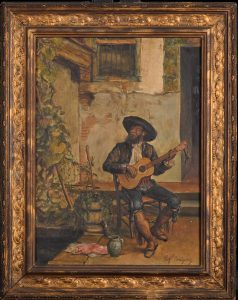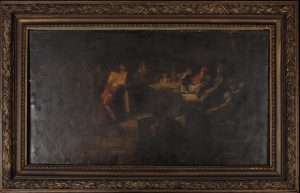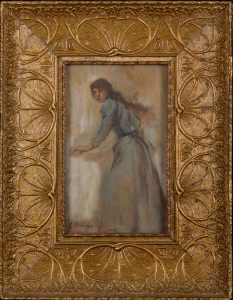Hysteric, Gypsy, Heretic
I am intrigued by the phrase that this endeavor activates. As an art historian and a curator of modern and contemporary art, the formulation “all the missing limbs” leans towards the melancholy that afflicts art history’s desire to trace the poignant light of art’s elusive past. That said, the discipline confronts this distinct material through methods invested in annotating sensuous particularity in a timely present. In many different ways then, the art is always before the art historian and the curator. Michael Baxandall reminds students of the history of art that the language of its explication is ostensive, that is, demonstrative or exemplifying though marked by all varieties of indirection.1 This means that the art historian decisively but indirectly points to something specific: this face in this painting and not just any face in any painting. In this instance, the limbs are central in the act of pointing to the work of art whether as primary document or evidence or aesthetic object or cultural text or sensible form. As a curator of a museum, I always point to works when I try to propose a passage into the picture. But before I get to do that, I exercise the hand in hanging it, putting it on some kind of support or supplement, and therefore making it visible, if not altogether charismatic.
This is why I begin with the question: What does it mean to hang colonial paintings in a university museum in Manila? The university was conceived by the colonial regime of the United States in 1908, and the museum’s collection was donated by a political and cultural personage, Jorge B. Vargas, who was born during the Spanish era and served in the bureaucracies of both the United States and Japanese governments in the first half of the twentieth century. The university and the museum, two of modernity’s vital institutions of secular and universal knowledge, host colonial possessions and their histories. How do these discourses, alongside the apparatus of art history, render the colonial reasonable? This reflection speaks to the impulse of this project to craft the contexts of the hand as an index of complicity in hanging and pointing, even as the images generate their own contexts which need not be reduced to or captured by the oftentimes overdetermining colonial. Through three paintings involving the tropes of the hysteric from the Salpêtrière hospital in Paris, the gypsy of al-Andalus in Islamic Spain, and the heretic in Galileo Galilei, the colonial is imagined, rather than misaligning itself at the outset from the extractive colonial venture, to permeate the latter’s remains and to propose curatorial reconstitution. In the said works, the hand is present: flailing, strumming a guitar, recanting a text.
Perhaps it would be productive to historicize the university and the museum as it relates to the university museum in Manila that I curate, the Vargas Museum. Needless to say, alongside the university and the museum, the Vargas collection’s donor forms part of this effort to situate.
The first president of the University of the Philippines, the American theologian Murray Bartlett, stressed the “moral value of work” and believed that “the surest and quickest way of bringing about the Filipinization of government is through the university.” His emphasis on “character” and his call not to “breed aristocrats, but unselfish workers for the common good” cohered with his vision for a Filipino university, thus his fixation on the discourse of the national: “There can be no greatness without nationality. The world-centers of knowledge are essentially national. With students from all parts of the world, Berlin is essentially German and Oxford essentially English. This university should not be a reproduction of the American university … it must grow in Philippine soil, it must not be transplanted from foreign shores.”2

Rafael Enriquez, Sr., Un Gitano Tocando La Guitarra, undated, oil on panel. Vargas Museum Permanent Art Collection.
I juxtapose this scene of the university with the moment of the museum. The Philippine polymath patriot José Rizal, who later would become the National Hero, writes in the 1891 novel El Filibusterismo (translated as The Reign of Greed by Charles Derbyshire) a chapter titled “The Class in Physics.” Rizal first describes the nearly clinical classroom, and then zeroes in on an intervening substance of both enigma and disdain that reveals and obscures, excludes, and invites under the auspices of the curate-curator. The school is the University of Santo Tomas, run by Dominican friars, which began to be formed in 1605 and became a university in 1645. According to Rizal:
The walls, painted white and covered with glazed tiles to prevent scratches, were entirely bare, having neither a drawing nor a picture, nor even an outline of any physical apparatus. The students had no need of any, no one missed the practical instruction in an extremely experimental science; for years and years it has been so taught and the country has not been upset, but continues just as ever. Now and then some little instrument descended from heaven and was exhibited to the class from a distance, like the monstrance to the prostrate worshipers—look, but touch not! From time to time, when some complacent professor appeared, one day in the year was set aside for visiting the mysterious laboratory and gazing from without at the puzzling apparatus arranged in glass cases. No one could complain, for on that day there were to be seen quantities of brass and glassware, tubes, disks, wheels, bells, and the like—the exhibition did not get beyond that, and the country was not upset.
Besides, the students were convinced that those instruments had not been purchased for them—the friars would be fools! The laboratory was intended to be shown to the visitors and the high officials who came from the Peninsula, so that upon seeing it they would nod their heads with satisfaction, while their guide would smile, as if to say, ‘Eh, you thought you were going to find some backward monks! Well, we’re right up with the times—we have a laboratory!’3
This is an exemplary situation of learning, relearning, and unlearning. It can be read as an allegory of regulated seeing and representing, of being in the same place of the device but distanced from it. A key element in this moment is the simultaneously alienating and alluring glass, the modern surface that guarantees the illusion of transparency and heightens the desire for opaque property.
This story might take us back to the birth of the clinic, or the teaching hospital in the eighteenth century, in the work of Michel Foucault, who discusses the medical gaze. It was a gaze, according to Foucault, that was not “bound by the narrow grid of structure … but that could and should grasp colors, variations, tiny anomalies, always receptive to the deviant … it was a gaze that was not content to observe what was self-evident … it was calculating.” Foucault is led to conclude that “the technical armature of the medical gaze is transformed into advice about prudence, taste, skill: what is required is ‘great sagacity,’ ‘great attention,’ ‘great precision,’ ‘great skill,’ ‘great patience.’”4 The aesthetic and the scientific, therefore, would condense in the gaze in the classroom and the teaching hospital. In Rizal and Foucault, physics and metaphysics are embodied by a range of pedagogies in the classroom, the museum, and the hospital.
Jorge Vargas was a bureaucrat from the elite with interests in sugar. He was born in the final decade of Spanish colonialism in the nineteenth century and served the successive colonial governments of the United States and Japan. During the Pacific War, when the President of the Philippine Commonwealth fled to Australia, Vargas became the highest official who worked with the Japanese. When the Americans came back, he was tried for collaboration but was absolved by the postwar Philippine administration. Vargas was an avid collector of art, books, coins, stamps, photographs, and documents; and was an advocate of international sports and the scouting movement. He was in the pioneer class of the Law School at the University of the Philippines and at some point, became its Regent. He donated a large part of his collection to the University, which built the Jorge B. Vargas Museum and Filipiniana Research Center in his honor.5
A 1948 document that conceptually forms the basis of the Vargas collection views the pieces as “representative of a national art.” The same document refers to the first catalogue of 1943 that spells out the aims of the collection: “‘encouraging Filipino artists and assisting in the presentation of their works’ … helping ‘Filipinos to know and treasure our cultural heritage’ … and … contributing ‘to the proper presentation of Philippine art.’” The overarching vision of Vargas was to mesh the flesh and spirit of the Filipino in the endeavor to “express all the loftiness and all the greatness in his race in the creation of works of art.” This project of congealing the Filipino requires the “accumulation” of “creations which becomes ‘the gauge of the level of his culture.’” In his words: “The soul’s hunger for the beautiful is as imperative as the needs of man’s body.” Vargas, in this time of reconstruction after the war had staggeringly pummeled Manila in the magnitude of Warsaw and Dresden, located this vision amid devastation and the travails of renewal; and he was cognizant of the “racial superiority” that enables colonialism of any kind as well as the warfare that may be waged by “cultural guerrillas” in a “cultural war.” The war must have so scarred Vargas that his collective habitus, manifesting in nation and art, was wrought to fulfill the promise of the “fundamental greatness of the conquered race.”6

Juan Luna, Trial of Galileo, undated, oil on canvas. Vargas Museum Permanent Art Collection.
Vargas, the collector and a vanguard of the collective that is the nation, wrote an essay in 1910 titled “What is the University of the Philippines?” According to Vargas:
The University as a meeting place of diverse provincial students all interested in the various departments of human learning and resolutely working for the building up of their country, means much to the Filipino people. Here, the differences of tribe, dialect, and place are obliterated by the community of aim worked out in common understanding. Higher ideals and broader views are infused, and the studious early learn to appreciate the benefits of a common tongue … his sympathies are widened,—the Visayan learns to love the Tagalo, the Tagalo the Ilocano, and so on around the circle. Mutual appreciation is evolved; so that the Filipinos may someday be able to act unitedly and intelligently on their problems of national importance.7
Ideas around the “common,” “sympathies,” and the “national,” therefore, conjured in Vargas’s mind, are the basis of the “collection.”
The second moment of this essay looks into how a contemporary museology can complicate the historiography of art and insinuate a frisson, which is both a criticality and an attraction to forms. It is through this attentiveness that I propose to unhinge the museum from its coloniality. In this regard, three paintings of the Vargas collection from the colonial period foreground figures that threaten the rationality of history, ethnicity, and subjectivity. In Rafael Enriquez (who was the first director of the School of Fine Arts of the University of the Philippines), it is the gypsy from al-Andalus of southern Spain, playing the guitar in the work titled Un Gitano Tocando la Guitarra (A Gypsy Playing the Guitar, 1886). The imagination of a migratory, itinerant, diasporic subject such as the Asian Romani, whose personhood had been and continues to be suppressed in Europe, confuses the project of identity of race or nation in Spain, which used to be the colony of the Roman and Islamic empires. In Juan Luna’s Trial of Galileo, it is the physicist, astronomer, and engineer Galileo Galilei in the setting of a trial in which he is forced by the Catholic Inquisition to disavow his theory of the Earth revolving around the Sun. And in Félix Resurrección Hidalgo’s De la Salpêtrière (From Salpêtrière), it is the woman patient in the Parisian hospital Salpêtrière, possibly a hysteric being treated in the facility known for isolating the deranged and female prostitutes. For me, these tropes of the gypsy, the heretic, and the hysteric intimate a discrepant worldliness that disconfirms the colonial or civilizing fantasies of epistemological and social integration. It must be noted that Luna, the painter of the heretic, and Hidalgo, the painter of the hysteric, were conferred Gold and Silver honors respectively at the Madrid Exposition in 1884: Hidalgo for his Las Virgenes Expuestas al Populacho (The Christian Virgins Exposed to the Public) and Luna for his Spoliarium. Such an achievement of colonial natives in Europe prompted José Rizal, the interlocutor of the first museum embedded in the physics class, to proclaim the end of the colonial and the commencement of the universal. As he put it during a toast: “Genius knows no country like light, air … the patrimony of everybody, cosmopolitan like space, like life, like God.”8 The three artists—Enriquez, Hidalgo, and Luna—were all reared in the Academy as articulated in Manila and in Europe. The Academy was the site of transfer of Western-style academic realism and cultivated the aspiration to a national tradition within art history and a nineteenth-century nationalism in the realm of civic virtue. It must be mentioned, however, that viewing the works in the Vargas Museum and finding them in Philippine art history, we strain to see them: Luna’s piece is a study, its details imprecise under glass; Hidalgo’s portrait is unprepossessing, being only 22 x 14 centimeters; and the corpus of Enriquez, unlike Luna’s and Hidalgo’s magisterial stature, is not well explored, its examples very scarce.

Felix Resurrección Hidalgo, De La Salpêtrière, undated, oil on wood. Vargas Museum Permanent Art Collection.
The third moment of this proposition is the presence of limbs in the paintings, extensions of the eccentric and unruly subjectivities of the personas being depicted, performing a certain condition that may reference memory inscribed in music, or discourse contested within science, and illness treated in a hospital and the protocols of medicine. These limbs express vitality or edginess, reminding me of the work of the Italian philosopher Adriana Cavarero on inclination and her critique of rectitude. For her, subjectivity is formed in vulnerability and that the “emphasis on vulnerability, in the relational model invoked here, is therefore first of all an accent on politics, ethics, and the social … to think relation itself as originary and constitutive, as an essential dimension … [of] being creatures who are materially vulnerable and, often in greatly unbalanced circumstances, consigned to one another.”9
Through the gestures of animate subjects that are at the same time tropes and indices of inclination, the university museum, or the museum university as contemplated by Clémentine Deliss, can finally begin to play out elsewhere. Instead of de-installing the works, the museum re-inclines them, so that the stifled energies residing within their frames may predispose the pedagogy of the museum and challenge the hegemonic linearities of art history and the representational systems of curatorial orthodoxy. These tropes or figures may become, not themes to be merely pointed to or pointed at, but poetic and political limbs to walk the public through the museum, their valences redistributed across the collection and, by extension, the collective of any potential movement. It is in this light that I would like to propose, or presuppose, a theory and an ethos of imbrication to mediate the avant-garde obsession with rupture or disruption; confoundedness to disperse the thickness and alacrity of critique; rightfulness through deliberation rather than righteousness through ideology; protracted patience to chasten punctual agency; and alternating scales of restitution rather than an alternative and singular sovereignty of resolution.
Patrick Flores is Professor of Art Studies at the Department of Art Studies at the University of the Philippines and Curator of the Vargas Museum in Manila. He is the Director of the Philippine Contemporary Art Network. He was a Visiting Fellow at the National Gallery of Art in Washington, D.C. in 1999. Among his publications are Painting History: Revisions in Philippine Colonial Art (1999); Past Peripheral: Curation in Southeast Asia (2008); Art After War: 1948-1969 (2015); and Raymundo Albano: Texts (2017). He was a Guest Scholar of the Getty Research Institute in Los Angeles in 2014. He was the Artistic Director of Singapore Biennale 2019 and Convener of the Forums for the Taiwan Pavilion at the Venice Biennale in 2022.
Footnotes
1 Michael Baxandall, “The Language of Criticism” (1966), in Salim Kemal and Ivan Gaskell (eds), The Language of Art History, Cambridge, MA, 1991, pp. 67–75. 1
2 Patrick Flores, “Collective,” in Flores (ed.), The Vargas Collection: Art and Filipiniana, Manila, 2020, pp. 10–37. 2
3 José Rizal, El Filibusterismo (The Reign of Greed), trans. Charles Derbyshire, Manila, 1912, p. 115. 3
4 Claude Roucher-Deratte, Leçons sur l’art d’observer, Paris, 1807, pp. 87–99. Quoted from Michel Foucault, The Birth of Clinic: An Archeology of Medical Perception, trans. A. M. Sheridan, London, 2003, p. 121. 4
5 Flores, in The Vargas Collection: Art and Filipiniana, p. 214. 5
6 Archival document, Jorge B. Vargas Museum and Filipiniana Research Center. 6
7 Jorge B. Vargas, “What is the University of the Philippines?,” in College Folio (October 1910), pp. 19–20. 7
8 José Rizal, “Rizal’s Speech Delivered at the Banquet in Madrid in Honor of the Filipino Painters Juan Luna and Felix Resurrección Hidalgo (June, 25, 1884),” in Political and Historical Writings: José Rizal, Volume 7 of the Philippines National Heroes Commission, Manila, 1972, p. 18. 8
9 Adriana Cavarero, Inclinations: A Critique of Rectitude, trans. Amanda Minervini and Adam Sitze, Stanford, CA, 2016, p. 13. 9
May 13th, 2022 — Rosa Mercedes / 04